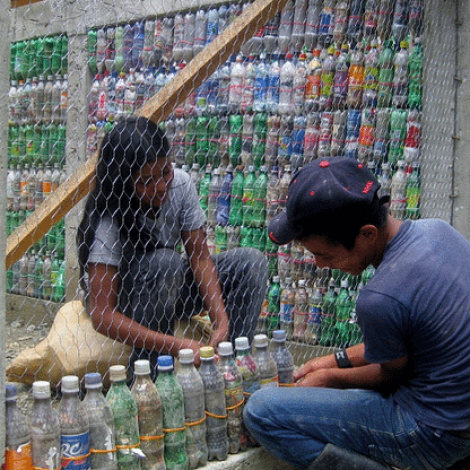Chip off a chunk of cement from the wall of the elementary school in Granados, Guatemala, and you’ll see that its interior is a neatly stacked layer of plastic bottles. School children collected 5000 20-ounce soda bottles, once destined for landfills, garbage fires, rivers or the sides of roads in this cloud-forested region northeast of Guatemala City. They stuffed the bottles tightly with plastic grocery sacks, potato chip bags and other inorganic trash, lined them up between layers of chicken wire and covered them with cement. With volunteer labor and trash as a building material, the school for nearly 300 children cost less than $6000 to build.
Granados’ school is one of 12 plastic bottle schools that the San Diego-based non-profit Hug It Forward helped build in Guatemala for less than $15,000 each. Hug It Forward pays for part or all of a school’s construction. Its members teach volunteers from the community to manage volunteer labor, work with paid engineers, gather bottles and build the schools. The schools are built around sound frames with trash-filled bottles as insulation.
How to build a bottle school
Now, Hug It Forward has just completed a construction manual to spread its bottle school gospel as far as the Web will take it.
“The idea is that anyone in the world can build a bottle school,” says Heenal Rajani, one of Hug-It-Forward’s small- but-dedicated band of full-time volunteers.
Rajani’s team is planning a test-run of the manual in a community in Guyana. The builders, together with a Peace Corps volunteer, will work entirely from the manual, asking Hug It Forward for advice as little as possible.
“We hope that we’ll be able to keep taking a step back and a step back and a step back,” Rajani says. Like many good aid organizations, Hug It Forward is trying to work itself out of a job. Ultimately, his team envisions a self-sustained online bottle school advice forum built around the manual. Communities would apply for construction grants, and funding would come from international donors.
Video: See Hug It Forward and the community at Granados, Guatemala, build a bottle school.
Communities lead
Hug It Forward began with an idea for funding projects and promoting friendship by monetizing hugs. This is how it works: People hug each other, ask the hugees to register their hugs on Hug It Forward’s site, and socially conscious businesses donate $1 for bottle schools.
Peace Corps volunteers introduced Hug It Forward to bottle schools when they alerted the charity’s founders to a partially-constructed bottle school in Guatemala that was underfunded. Hug It Forward raised money from its donors and led a work trip to finish the school.
“We saw how the children and the parents are involved and how it brings people together. We asked, How can we systematize this?” Rajani says. “We wanted to provide communities with expertise and money to make it work.”
Hug It Forward developed a process that is mostly hands off. The organization pays expenses and offers advice, but lets communities take charge of building their own schools. Hug It Forward doesn’t even pitch the idea—communities seek it out, instead.
“Good news spreads fast, and people come to us,” Rajani says.
The 100% promise
Two of the principles that we admire at the heart of Hug It Forward are its transparency and commitment to frugality. Private donors cover the organization’s administrative and travel costs, so every cent that the public gives is spent on building schools. It is frugal both in its structure—the core team is unpaid—and in its expenditures—bottle schools built by community volunteers are cost effective.
“We like that Hug It Forward maintains its purity of 100%,” Rajani says. “Everything that you donate goes down to the schools in Guatemala. Donors see our passion in what we’re doing and that resonates with them as well.”
For more information, to learn how to give trackable hugs, and to donate, please visit Hug It Forward’s web site.


I like this innovative thinking,thank you E4C